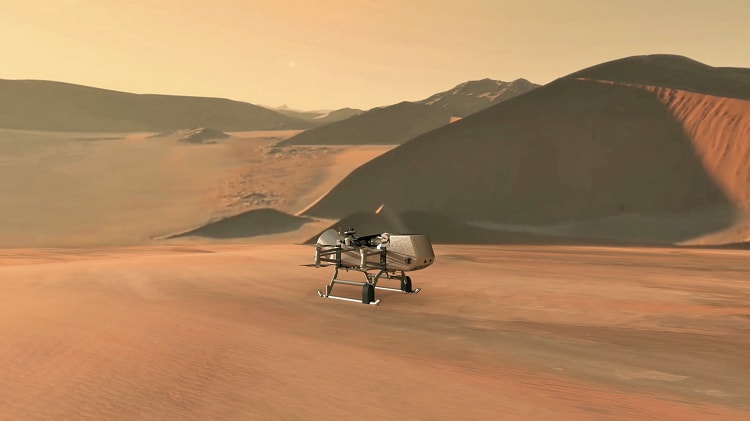NASA is going to Titan (Saturn’s Moon) in search of building blocks of life. The agency revealed on Thursday, June 27 that it is planning to launch a mission called Dragonfly, a rotorcraft-lander designed to fly dozens of promising locations across the icy moon that could have sparked biology on the early earth.
Dragonfly will launch in 2026 and land on Titan eight years later i.e. 2034. The probe will then spend at least 2.5 years on Titan and explore around 3,200 mile-wide moon through diverse environments from organic dunes where life, water, and complex organic materials once existed for possibly tens of thousands of years. It will also investigate the moon’s atmospheric and surface properties. Also, for chemical evidence of past and extant life.
Saturn’s Moon Titan has its own seasonal cycles, winds, river, and lakes but with an exotic twist. Actually, its atmosphere is four times denser than Earth and it rains liquid methane and other organic compounds onto the moon’s surface. Larger than the Mercury, it is the second largest moon after Ganymede (Jupiter’s moon) in the whole solar system that has a thick water-ice crust.
Titan is known for its vast lakes that are filled with hydrocarbons and not with water. Titan is about 886 miles from the Sun having a surface temperature of -290 degrees Fahrenheit.

The probe will first land on “Shangri-la” dune among other Titan’s dunes. The dune is similar to linear dunes found in Namibia in Southern Africa. Then, making its way to the final destination Selk Crater which is 50-miles-wide (80 km) and is particularly a better place to study prebiotic chemistry and past evidence of life.
Carrying multiple cameras for capturing pictures on its journey, Dragonfly rotorcraft-lander will eventually fly more than 108 miles (175 km) which is nearly double the distance covered to date by all Mars rovers combined.
Dragonfly will be equipped with the tools of material samples of either past or present life, NASA is not sure what it might find. It will be powered by the Multi-Mission Radioisotope Thermoelectric Generator (MMRTG), like the one the Curiosity rover uses on Mars, which converts the heat released by the decay of radioactive material into electricity.
Dragonfly will be the fourth mission in NASA’s New Frontiers Program, following New Horizons, the Juno probe to Jupiter and the OSIRIS-REx asteroid-sampling mission. Dragonfly’s development cost is capped at $850 million and if we include launch cost, the total will probably cross $1billion.
Dragonfly is a one of a kind mission by NASA which may unveil various mysterious that we are unaware of. NASA Administrator Jim Bridenstine said, “Visiting this mysterious ocean world could revolutionize about what we know about life in the universe. This cutting-edge mission would have been unthinkable even just a few years ago, but we’re now ready for its flight.”

